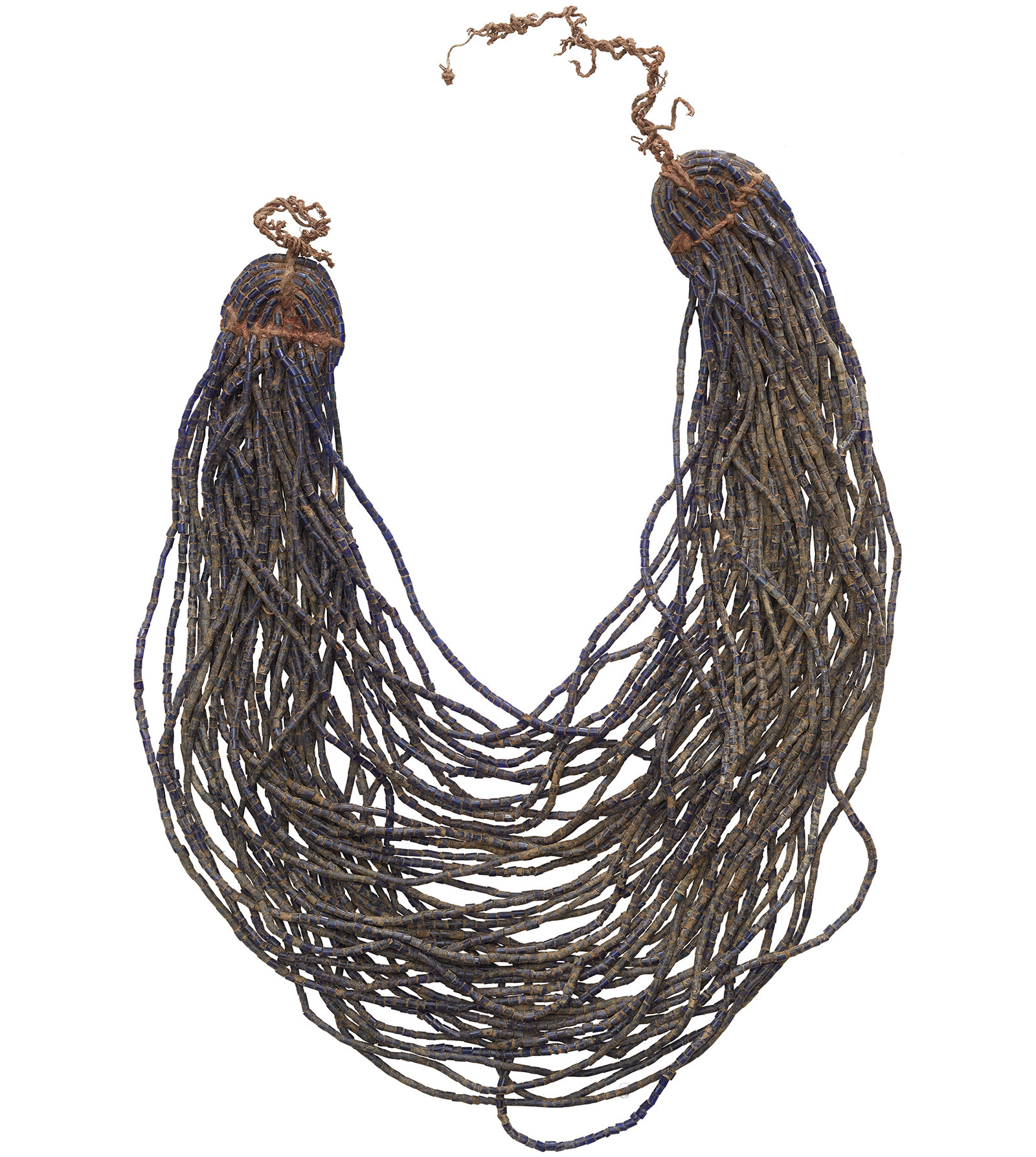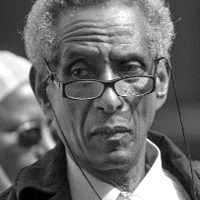The importance of Mahdism in Sudan and why UK museum's presentation of this history is controversial.
Item
Title
The importance of Mahdism in Sudan and why UK museum's presentation of this history is controversial.
Creator
Subject
Interview with Osman Nusairi - Can you tell us why Mahdism is so important in Sudan, and why British Museums rendering of Mahdist artefacts is controversial?
Description
Excerpt from interview with Osman Nusairi.
The period of Mahdist rule of Sudan is the most significant and distinguished aspect of modern Sudanese history. It began in 1885, with the defeat of General Gordon in Khartoum, after which there was a twelve year period of national government. The Mahdi himself did not live for more than 6 months after the liberation of Khartoum and the killing of General Gordon, but his successor Khalifa Abdullahi remained for about 12 years. There is a heavy presence for that period in Sudanese consciousness, and it is well documented.
In British museums, the artefacts and pieces related to that history, particularly about Mahdism itself, are obviously spoils of war – it is essentially loot. They are not there just to document history in a neutral way, but to celebrate a victory and the spoils are there to prove it. What is positive is that it is looked after and it is made accessible to visitors. But from my experience of some museums, particularly the Royal Engineers Museum, it is clear that museums do not tell the whole story. No one would expect a military museum to be self-loathing and to declare that arms are killing machines and what is there is the proceeds of what killing machines can do. But on the other hand, it is crucial when presenting objects emanating from war to do so in a context, and which reflects on life and not just on killing. The people defeated by British forces are people who have got lives, and the killing that is the outcome of a victorious war should not be presented as something to be particularly proud of. It is something that happened. But context is essential.
What I see in the Royal Engineers Museum, is that General Gordon is presented basically as a hero. There is an image of him looking over smaller people, as his enemies who are in his palace. But this is propaganda. In my view, Gordon should be seen as someone who was totally incapable of understanding the people and the culture he was dealing with. Ignorance might be the key to understanding him, and arrogance, obviously. He was tolerated to a certain extent, but he was unreliable - a loose cannon at the best of times, and ill prepared for the job. So, rather than presenting him as a competent man who was slain by savages, he should be presented as someone who totally misunderstood what the whole business of government was about. Even British parliament and newspapers at the time, like The Times, were shocked at him being sent to Sudan by the Egyptian government and at his public announcement to people on his arrival there that he was not there to stay but rather was there to evacuate the country. As a result, he had few friends aligning around him. In addition, it was a great shock that he endorsed and accepted slavery as an institution in Sudan, promising that it would not be prohibited. This endorsement of slavery put him in the same position as those the British condemned as slave drivers, such as Zubair Basha, who the Anti-Slavery Society considered to be the biggest slave driver in Sudan. Indeed, Gordon wanted Zubair to rule Sudan and tried to approach him, but Zubair was unprepared to do business with Gordon, he would not even shake hands with him.
From Gordon’s actions, you can see that he did things that only an unintelligent man would do. He sent presents to El Mahdi that included finery and nice clothing, yet the Mahdi was condemning the corrupt rule that such clothing represented. He also presented the Mahdi with other totally inappropriate and demeaning items of costume that were associated with ordinary sheikhs and tribal chiefs, showing no appreciation of his power, beliefs and status – he sent him a Fez, for example, which was a symbol of Ottoman-Egyptian corruption and rule. The Mahdi was promoting simple, coarse, very basic clothing – forms of dress culturally accepted by the Mahdist movement. By presenting Gordon as an honourable and competent leader, the Museum is not conveying his errors. Another example – Gordon sent back to Cairo the cipher book that would have allowed him to understand the letters being sent to him by his employers. What kind of mentality would do that? Having sent it back, he then sat there in Khartoum incapable of comprehending what London or Cairo was telling him. So that aspect of the life of Gordon is not conveyed in the Museum, though the contemporary press in Britain was very aware of that.
There are other aspects too that are not communicated by Museums. For example, in parliament at the time in Britain, a key issue was the treatment of the Sudanese war wounded. According to some statistics, around 50,000 Ansar fighters took part in the major battle in the second of September 1898 in Karari, Omdurman. Around 10,800 were calculated to have been killed and around 4000 deserted the battlefield and escaped. The remainder were likely wounded, but they are not properly represented in the statistics. The official figure of those wounded was given as about 16,000, which was a very low estimate, and official documents would refer to them as being treated at home. But injuries and wounds sustained by the modern weaponry used by the British could not be treated in homes. There was an attempt to do a fake hospital - an Egyptian who was already in the Sudan called Hasan Zeki was a physician and was entrusted with the task of creating this hospital. But imagine – the responsibility for such a hospital was not given to an officer of the British army, but entrusted to someone who used to be a prisoner of the Mahdi himself. In the weeks following the battle he said he attended to about 300 seriously wounded people. But then obviously there are huge numbers who were not offered treatment. There was an explanation given that there were so many that they couldn’t cope. But the accusations of soldiers actually killing the wounded were ignored. These atrocities and the contemporary controversy over them in Britain are not conveyed. I think that aspect is particularly important in relation to the debate about what a military museum is supposed to do – is it there to celebrate war? Or should it be responsible for putting a context to make people understand that these were controversial episodes, and that there is more than simply this one celebratory view?
Then there is also the controversy as to who these objects really belong to. In British universities there have been protests against colonial rulers being celebrated, and there are movements for compensation or acknowledgement of guilt for the whole issue of the colonial experience in Africa. As with the Jewish experience, people need to accept responsibility and even offer compensation in some form. There are calls for the return of looted treasures back to countries of origin. In the case of the Sudan, the return of looted cultural heritage is not the key issue at the moment – what is important now is trying to balance or to counter balance what museums in Britain are depicting. People and institutions in Sudan are not yet ready to look after these artefacts and to render them accessible. What could be useful would be a form of admission that they are on historical loan, awaiting a time when they will be claimed by their rightful owners, or when a neutral organization – a body like UNESCO perhaps - would help ensure they are looked after properly and made accessible and not looted like the Islamists did in Sudan, stealing our museum pieces and selling them to an Arab country for their own profit. In the meantime, I think more focus on counterbalancing the presentation or portrayal of other people in British museums would be expected and highly respected.
What is also not highlighted in British museums, is that there was an Egyptian input in what they call the reconquest of Sudan. While the numbers of British officers killed is well known - 5 officers and 51 non-commissioned officers – the 15 Egyptian officers and 228 non-commissioned officers wounded and killed are rarely included. A greater part of the deaths on the Anglo-Egyptian side were Egyptians or Sudanese who were part of the Egyptian army, but their role is not emphasised, even within Sudan itself, it is rarely mentioned that there were many Sudanese tribes involved in the fight against the Mahdist forces on the Anglo-Egyptian side. The Mahdist’s call was radical – it was an understanding of Islam that denied even the Ottoman emperors as representative of Islam. The Ansar (‘supporter’) who fought under the banner of Mahdism believed in what they were doing, they were not recruited like others. For example, the Anglo-Egyptian forces defeated by the Mahdi in the battle of Sheykan, largely comprised the troops of the Egyptian army general Ahmed Orabi who was a nationalist and had led a revolt against the British in Egypt. These same people who were in rebellion against the British in Egypt were actually sent into a totally hopeless mission to be annihilated at Sheykan. Most of the troops that were involved in the battle of Omdurman under the command of the British army were not clear what they were fighting for, while the Ansar knew what they were fighting for. The Ansar knew they were fighting for a cause, they might have been misguided, it might be wrong, but they believed it and they knew that this is their country and others are foreigners. That was not the case for others, the forces led by the British did not know what they were doing, unless they were told, there are savages here and we have to go and kill them. So, there are many aspects of Mahdism that are not highlighted - that it was a rejection of corrupt rule which took the form of an Islamic understanding that was not shared by every Sudanese, and there were many tribes who were against it.
I think the behaviour of the British army in the conduct of these wars also needs to be revised, especially as it is presented in many Museums. Let me give an example of a case of atrocity and war crimes. The Khalifa Abdullahi is a Caliph who ruled in Sudan at the time of the Omdurman battle, who was in a state of retreat for more than a year after the battle was over, as he was retreating to the western part of the country. During this retreat, when he was not fighting anyone, he was surrounded by British forces. He made a gesture of surrender - he was sitting, squatting, he was not carrying arms, he was not standing up – but he was killed together with some of his unarmed aides. So, this meant the British killed someone who was basically a prisoner of war, not showing any form of resistance whatsoever, he was just sitting down. Some attempts were made to explain that this is an Arabian tradition of people just sitting waiting for death. Nothing like that! Even if so, you don’t kill them for that, just for waiting, when they are not raising arms. He was executed without trial. That was never acknowledged as a war crime.
Mahdism was an important episode. It was an important African Sudanese resistance movement to colonialism. It would take time for a national government to build an ability to rule a county as vast and as complex as Sudan. For 12 years, Mahdism held the country together, at a very heavy price and with a high measure of horror as well. It was a foundational movement for Sudan as a nation.
In British museums, the artefacts and pieces related to that history, particularly about Mahdism itself, are obviously spoils of war – it is essentially loot. They are not there just to document history in a neutral way, but to celebrate a victory and the spoils are there to prove it. What is positive is that it is looked after and it is made accessible to visitors. But from my experience of some museums, particularly the Royal Engineers Museum, it is clear that museums do not tell the whole story. No one would expect a military museum to be self-loathing and to declare that arms are killing machines and what is there is the proceeds of what killing machines can do. But on the other hand, it is crucial when presenting objects emanating from war to do so in a context, and which reflects on life and not just on killing. The people defeated by British forces are people who have got lives, and the killing that is the outcome of a victorious war should not be presented as something to be particularly proud of. It is something that happened. But context is essential.
What I see in the Royal Engineers Museum, is that General Gordon is presented basically as a hero. There is an image of him looking over smaller people, as his enemies who are in his palace. But this is propaganda. In my view, Gordon should be seen as someone who was totally incapable of understanding the people and the culture he was dealing with. Ignorance might be the key to understanding him, and arrogance, obviously. He was tolerated to a certain extent, but he was unreliable - a loose cannon at the best of times, and ill prepared for the job. So, rather than presenting him as a competent man who was slain by savages, he should be presented as someone who totally misunderstood what the whole business of government was about. Even British parliament and newspapers at the time, like The Times, were shocked at him being sent to Sudan by the Egyptian government and at his public announcement to people on his arrival there that he was not there to stay but rather was there to evacuate the country. As a result, he had few friends aligning around him. In addition, it was a great shock that he endorsed and accepted slavery as an institution in Sudan, promising that it would not be prohibited. This endorsement of slavery put him in the same position as those the British condemned as slave drivers, such as Zubair Basha, who the Anti-Slavery Society considered to be the biggest slave driver in Sudan. Indeed, Gordon wanted Zubair to rule Sudan and tried to approach him, but Zubair was unprepared to do business with Gordon, he would not even shake hands with him.
From Gordon’s actions, you can see that he did things that only an unintelligent man would do. He sent presents to El Mahdi that included finery and nice clothing, yet the Mahdi was condemning the corrupt rule that such clothing represented. He also presented the Mahdi with other totally inappropriate and demeaning items of costume that were associated with ordinary sheikhs and tribal chiefs, showing no appreciation of his power, beliefs and status – he sent him a Fez, for example, which was a symbol of Ottoman-Egyptian corruption and rule. The Mahdi was promoting simple, coarse, very basic clothing – forms of dress culturally accepted by the Mahdist movement. By presenting Gordon as an honourable and competent leader, the Museum is not conveying his errors. Another example – Gordon sent back to Cairo the cipher book that would have allowed him to understand the letters being sent to him by his employers. What kind of mentality would do that? Having sent it back, he then sat there in Khartoum incapable of comprehending what London or Cairo was telling him. So that aspect of the life of Gordon is not conveyed in the Museum, though the contemporary press in Britain was very aware of that.
There are other aspects too that are not communicated by Museums. For example, in parliament at the time in Britain, a key issue was the treatment of the Sudanese war wounded. According to some statistics, around 50,000 Ansar fighters took part in the major battle in the second of September 1898 in Karari, Omdurman. Around 10,800 were calculated to have been killed and around 4000 deserted the battlefield and escaped. The remainder were likely wounded, but they are not properly represented in the statistics. The official figure of those wounded was given as about 16,000, which was a very low estimate, and official documents would refer to them as being treated at home. But injuries and wounds sustained by the modern weaponry used by the British could not be treated in homes. There was an attempt to do a fake hospital - an Egyptian who was already in the Sudan called Hasan Zeki was a physician and was entrusted with the task of creating this hospital. But imagine – the responsibility for such a hospital was not given to an officer of the British army, but entrusted to someone who used to be a prisoner of the Mahdi himself. In the weeks following the battle he said he attended to about 300 seriously wounded people. But then obviously there are huge numbers who were not offered treatment. There was an explanation given that there were so many that they couldn’t cope. But the accusations of soldiers actually killing the wounded were ignored. These atrocities and the contemporary controversy over them in Britain are not conveyed. I think that aspect is particularly important in relation to the debate about what a military museum is supposed to do – is it there to celebrate war? Or should it be responsible for putting a context to make people understand that these were controversial episodes, and that there is more than simply this one celebratory view?
Then there is also the controversy as to who these objects really belong to. In British universities there have been protests against colonial rulers being celebrated, and there are movements for compensation or acknowledgement of guilt for the whole issue of the colonial experience in Africa. As with the Jewish experience, people need to accept responsibility and even offer compensation in some form. There are calls for the return of looted treasures back to countries of origin. In the case of the Sudan, the return of looted cultural heritage is not the key issue at the moment – what is important now is trying to balance or to counter balance what museums in Britain are depicting. People and institutions in Sudan are not yet ready to look after these artefacts and to render them accessible. What could be useful would be a form of admission that they are on historical loan, awaiting a time when they will be claimed by their rightful owners, or when a neutral organization – a body like UNESCO perhaps - would help ensure they are looked after properly and made accessible and not looted like the Islamists did in Sudan, stealing our museum pieces and selling them to an Arab country for their own profit. In the meantime, I think more focus on counterbalancing the presentation or portrayal of other people in British museums would be expected and highly respected.
What is also not highlighted in British museums, is that there was an Egyptian input in what they call the reconquest of Sudan. While the numbers of British officers killed is well known - 5 officers and 51 non-commissioned officers – the 15 Egyptian officers and 228 non-commissioned officers wounded and killed are rarely included. A greater part of the deaths on the Anglo-Egyptian side were Egyptians or Sudanese who were part of the Egyptian army, but their role is not emphasised, even within Sudan itself, it is rarely mentioned that there were many Sudanese tribes involved in the fight against the Mahdist forces on the Anglo-Egyptian side. The Mahdist’s call was radical – it was an understanding of Islam that denied even the Ottoman emperors as representative of Islam. The Ansar (‘supporter’) who fought under the banner of Mahdism believed in what they were doing, they were not recruited like others. For example, the Anglo-Egyptian forces defeated by the Mahdi in the battle of Sheykan, largely comprised the troops of the Egyptian army general Ahmed Orabi who was a nationalist and had led a revolt against the British in Egypt. These same people who were in rebellion against the British in Egypt were actually sent into a totally hopeless mission to be annihilated at Sheykan. Most of the troops that were involved in the battle of Omdurman under the command of the British army were not clear what they were fighting for, while the Ansar knew what they were fighting for. The Ansar knew they were fighting for a cause, they might have been misguided, it might be wrong, but they believed it and they knew that this is their country and others are foreigners. That was not the case for others, the forces led by the British did not know what they were doing, unless they were told, there are savages here and we have to go and kill them. So, there are many aspects of Mahdism that are not highlighted - that it was a rejection of corrupt rule which took the form of an Islamic understanding that was not shared by every Sudanese, and there were many tribes who were against it.
I think the behaviour of the British army in the conduct of these wars also needs to be revised, especially as it is presented in many Museums. Let me give an example of a case of atrocity and war crimes. The Khalifa Abdullahi is a Caliph who ruled in Sudan at the time of the Omdurman battle, who was in a state of retreat for more than a year after the battle was over, as he was retreating to the western part of the country. During this retreat, when he was not fighting anyone, he was surrounded by British forces. He made a gesture of surrender - he was sitting, squatting, he was not carrying arms, he was not standing up – but he was killed together with some of his unarmed aides. So, this meant the British killed someone who was basically a prisoner of war, not showing any form of resistance whatsoever, he was just sitting down. Some attempts were made to explain that this is an Arabian tradition of people just sitting waiting for death. Nothing like that! Even if so, you don’t kill them for that, just for waiting, when they are not raising arms. He was executed without trial. That was never acknowledged as a war crime.
Mahdism was an important episode. It was an important African Sudanese resistance movement to colonialism. It would take time for a national government to build an ability to rule a county as vast and as complex as Sudan. For 12 years, Mahdism held the country together, at a very heavy price and with a high measure of horror as well. It was a foundational movement for Sudan as a nation.
Publisher
Making African Connections
Contributor
Date
7 January 2020
Rights
© Making African Connections
Item sets
Linked resources
Filter by property
| Title | Alternate label | Class |
|---|---|---|
 Interview with Osman Nusairi Interview with Osman Nusairi |
Event |




